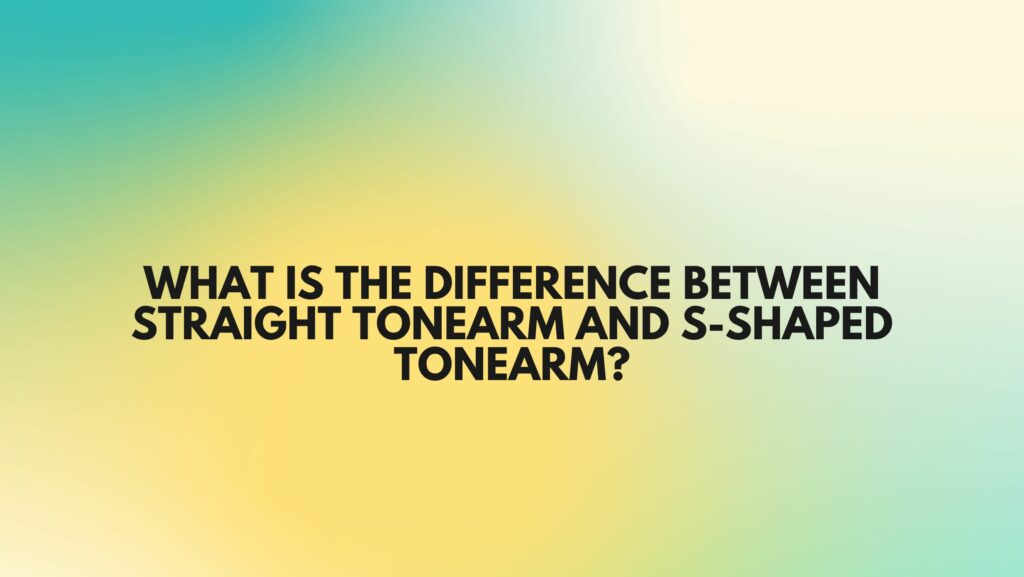Turntables, the beloved devices that bring the nostalgia and warmth of vinyl records to life, are complex instruments with various components influencing sound quality. Among these components, the tonearm stands out as a crucial element responsible for tracking the grooves and translating them into music. Tonearms come in different shapes and designs, with the two most common being the straight tonearm and the S-shaped tonearm. In this comprehensive article, we will delve into the differences between these two tonearm types, their impact on audio performance, and the factors to consider when choosing the right one for your turntable.
I. The Role of the Tonearm
The tonearm of a turntable plays a pivotal role in the playback process, serving as the bridge between the stylus (or needle) and the grooves of a vinyl record. Its primary functions are to hold the cartridge, guide the stylus across the record, and apply the necessary tracking force for accurate playback.
II. Straight Tonearm
A straight tonearm, as the name suggests, is designed with a linear and straight shape. This type of tonearm offers several distinct characteristics:
- Minimal Tracking Error: The straight tonearm’s design results in minimal tracking error, ensuring that the stylus remains perpendicular to the grooves throughout its entire path. This minimizes distortion and preserves the integrity of the recorded sound.
- Lower Resonance: Straight tonearms typically exhibit lower resonance due to their simplicity. This can contribute to a cleaner and more precise sound, especially when paired with a high-quality cartridge.
- Less Effective Anti-Skating: One potential drawback is that straight tonearms can be less effective at controlling anti-skating forces, which influence the stylus’s lateral movement across the grooves.
- Visual Aesthetics: Some listeners appreciate the clean and modern appearance of straight tonearms, which can complement contemporary turntable designs.
III. S-Shaped Tonearm
S-shaped tonearms, on the other hand, are characterized by their curved, S-like shape, which is more aesthetically pleasing to many enthusiasts. The distinctive features of S-shaped tonearms include:
- Effective Anti-Skating: S-shaped tonearms are often considered superior in terms of anti-skating control. They can effectively counteract the forces that cause the stylus to slide laterally across the record, contributing to better tracking and reduced distortion.
- Counterbalanced Design: The curved shape allows for effective counterbalancing of the tonearm, ensuring that the stylus exerts the correct tracking force on the record. This helps maintain groove integrity and sound quality.
- Aesthetic Appeal: The graceful curvature of S-shaped tonearms is a visual attraction for many, adding a touch of elegance and classic style to the turntable.
IV. Choosing the Right Tonearm
Selecting the appropriate tonearm for your turntable depends on various factors, including your personal preferences, your turntable model, and your budget. Here are some considerations to keep in mind:
- Sound Quality: Both straight and S-shaped tonearms can provide excellent sound quality, but the choice may influence the specific sonic characteristics of your turntable.
- Anti-Skating Needs: Consider the type of music you primarily listen to and whether effective anti-skating is a priority. S-shaped tonearms are typically superior in this regard.
- Turntable Compatibility: Check if your turntable allows for tonearm replacement or customization. Some turntables are designed with non-replaceable tonearms.
- Budget: Tonearms come in a wide range of prices, so it’s essential to align your choice with your budget.
- Visual Appeal: Don’t underestimate the importance of aesthetics. The look of your turntable can be as important as its sound.
V. Conclusion
The choice between a straight tonearm and an S-shaped tonearm ultimately comes down to personal preference and your specific audio and aesthetic goals. Both designs offer advantages and may suit different listening environments and music preferences. When upgrading your turntable or selecting a new one, take the time to consider these factors and make an informed decision that will enhance your vinyl listening experience, both in terms of audio quality and visual appeal. Whichever tonearm you choose, the art of tracking the grooves will continue to deliver the timeless enjoyment that vinyl records offer.

